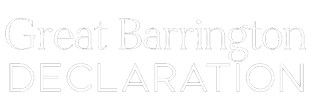How did the Great Barrington Declaration Come About?
Why was the Declaration written?
The Declaration was written from a global public health and humanitarian perspective, with special concerns about how the current COVID-19 strategies are forcing our children, the working class and the poor to carry the heaviest burden. The response to the pandemic in many countries around the world, focused on lockdowns, contact tracing and isolation, imposes enormous unnecessary health costs on people. In the long run, it will lead to higher COVID and non-COVID mortality than the focused protection plan we call for in the Declaration.
Who is the intended audience?
This is an international declaration, written with concerns for the entire world. It was written for the public, fellow scientists, and government officials.
Who wrote the Declaration?
The Declaration was written by Dr. Jay Bhattacharya, Dr. Sunetra Gupta and Dr. Martin Kulldorff. A family member and a journalist helped with phrasing, grammar, and proof reading. Nobody else saw the declaration before it was completed in its final form.
When was the Declaration written, signed and released?
The Declaration was written from October 2 to October 4, 2020. It was signed on October 4, after which it was sent to scientific colleagues. It was released to the public on October 5.
Who initiated the Declaration?
Dr Kulldorff invited Dr Bhattacharya and Dr Gupta to Massachusetts to record a video outlining an alternative to the current COVID-19 strategy. While meeting, the three spontaneously decided to also write a short Declaration to summarize the thinking.
Why was the Declaration signed in Great Barrington?
The Declaration was written and signed at the American Institute for Economic Research, located in Great Barrington, Massachusetts. The Institute kindly offered to help with the video recording, providing a location, equipment and a camera man pro bono.
How were the co-signers selected?
After finishing the Declaration, the three authors emailed a few colleagues asking them if they would co-sign. Most agreed. These original 30+ co-signers are listed on the front page, together with others that were added later.
Can anyone sign the Declaration?
Yes. Through the online form.
Are all the online signatures real?
No. Some pranksters added fake signatures such as Dr. Johnny Bananas, Prof. Spon’Ge’Bob SQ.UarePants, Dr. Neal Ferguson, Prof. Ware Thamask, and Dr. Person Fakename. In a strange twist, one journalist bragged on Twitter about adding fake names, after which other journalists criticized the Declaration for having fake signatures. Anyhow, the fake signatures are less than 1% of the total, and most have been removed from the count tracker.
Was anyone paid to write or sign the Declaration?
None of the authors or co-signers received any money, honoraria, stipend, or salary from anyone for either the Declaration or the video recording.
Do the three authors have any conflicts of interest?
Dr. Kulldorff works on research grants from the National Institutes of Health, the Centers for Disease Control and Prevention, the Food and Drug Administration and the non-profit Fund for Public Health in New York City, some of which is related to COVID-19. He has never accepted or received any funding from pharmaceutical companies, nor from any other large corporation.
Dr. Bhattacharya research funding over the past 22 years of his career has come almost entirely from grants from the National Institutes of Health, the National Science Foundation, the US Department of Agriculture, and participation on contracts with the Center for Medicare and Medicaid Services (CMS) and the Food and Drug Administration (FDA) via a government contracting research group, Acumen, LLC. He has never accepted or received any funding from pharmaceutical companies, nor from any other large corporation.
Dr. Gupta’s research funding over the last 30 years has principally been through fellowships and investigator awards from the Wellcome Trust and the European Research Council. She has also received funding from the UKRI, the Royal Society, the Leverhulme Trust, the Emily and Georg von Opel Foundation and the Oxford Martin School. She and Dr. Craig Thompson have developed a novel method for producing a universal influenza vaccine (derived from a mathematical model) and this has now been licensed and is going through early testing. She does not hold any consultancy contracts or stock shares in any commercial company.
